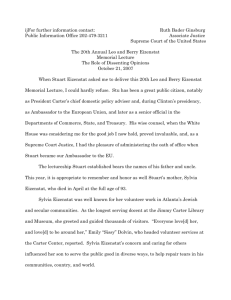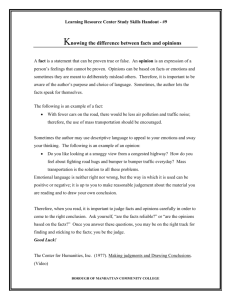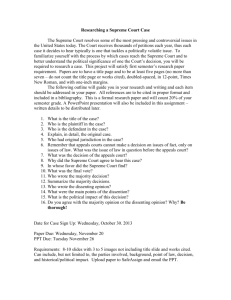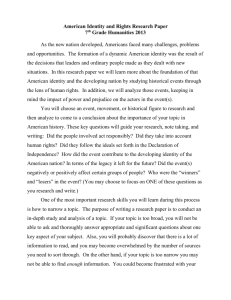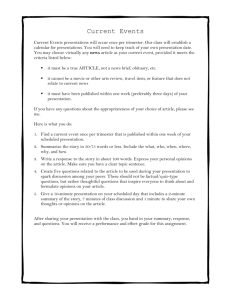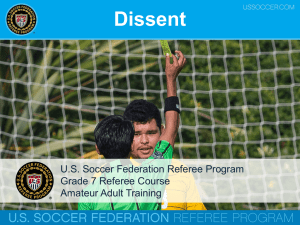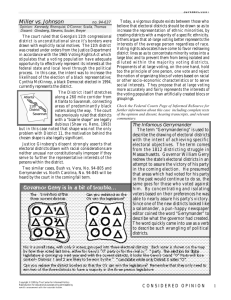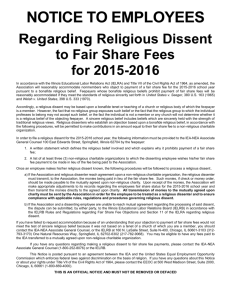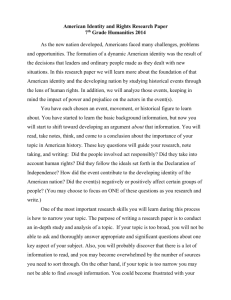The Role of Dissenting Opinions
advertisement
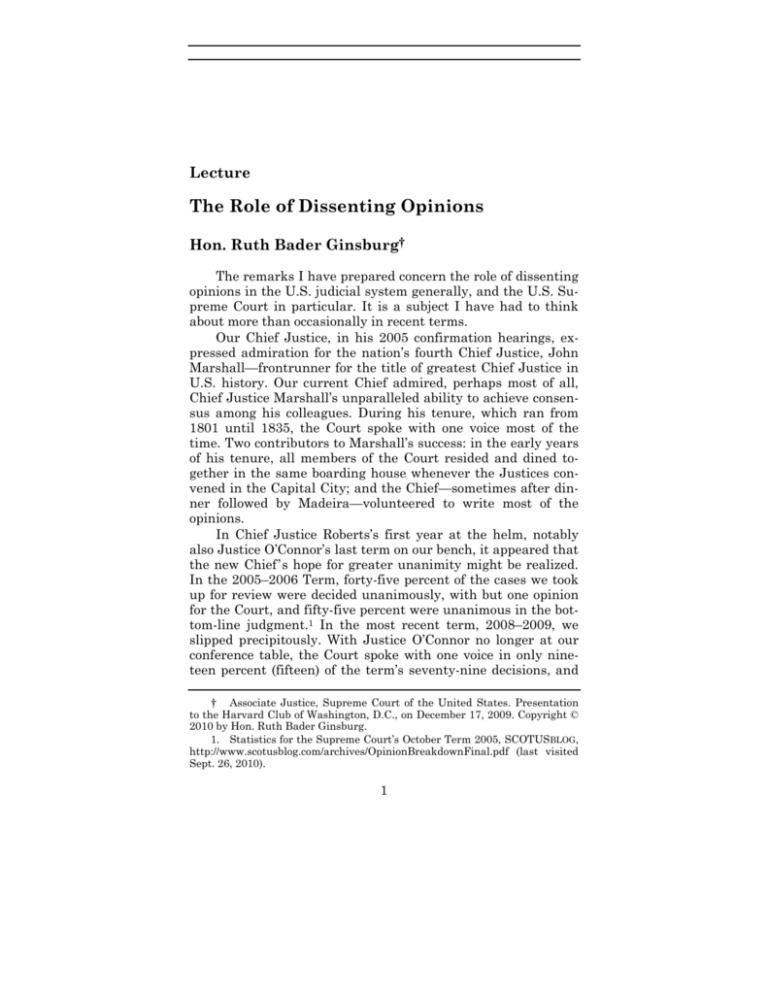
Lecture The Role of Dissenting Opinions Hon. Ruth Bader Ginsburg† The remarks I have prepared concern the role of dissenting opinions in the U.S. judicial system generally, and the U.S. Supreme Court in particular. It is a subject I have had to think about more than occasionally in recent terms. Our Chief Justice, in his 2005 confirmation hearings, expressed admiration for the nation’s fourth Chief Justice, John Marshall—frontrunner for the title of greatest Chief Justice in U.S. history. Our current Chief admired, perhaps most of all, Chief Justice Marshall’s unparalleled ability to achieve consensus among his colleagues. During his tenure, which ran from 1801 until 1835, the Court spoke with one voice most of the time. Two contributors to Marshall’s success: in the early years of his tenure, all members of the Court resided and dined together in the same boarding house whenever the Justices convened in the Capital City; and the Chief—sometimes after dinner followed by Madeira—volunteered to write most of the opinions. In Chief Justice Roberts’s first year at the helm, notably also Justice O’Connor’s last term on our bench, it appeared that the new Chief’s hope for greater unanimity might be realized. In the 2005–2006 Term, forty-five percent of the cases we took up for review were decided unanimously, with but one opinion for the Court, and fifty-five percent were unanimous in the bottom-line judgment.1 In the most recent term, 2008–2009, we slipped precipitously. With Justice O’Connor no longer at our conference table, the Court spoke with one voice in only nineteen percent (fifteen) of the term’s seventy-nine decisions, and † Associate Justice, Supreme Court of the United States. Presentation to the Harvard Club of Washington, D.C., on December 17, 2009. Copyright © 2010 by Hon. Ruth Bader Ginsburg. 1. Statistics for the Supreme Court’s October Term 2005, SCOTUSBLOG, http://www.scotusblog.com/archives/OpinionBreakdownFinal.pdf (last visited Sept. 26, 2010). 1 2 MINNESOTA LAW REVIEW [95:1 agreed unanimously in the bottom-line judgment in just under thirty-three percent (twenty-six) of the dispositions.2 Typically, when Court decisions are announced from the bench, only the majority opinion is summarized. Separate opinions, concurring or dissenting, are noted, but not described. A dissent presented orally therefore garners immediate attention. It signals that, in the dissenters’ view, the Court’s opinion is not just wrong, but grievously misguided. I will offer some examples in a short while. Our practice of revealing dissents, I should emphasize, is hardly universal. In the civil-law tradition that holds sway in Europe, and in countries once controlled by a continental power, courts—at least those in the regular court hierarchy—issue a collective judgment, cast in stylized, impersonal language. The author of the judgment is neither named nor otherwise identifiable. Disagreement, if it exists, as it sometimes does, is not disclosed. The British common-law tradition lies at the opposite pole. In appeals in that tradition, there was conventionally no “opinion for the court” at all. Instead, the judges hearing the case composed their own individual opinions which, taken together, revealed the court’s disposition. Changes in British practice and in some European tribunals have brought these divergent systems closer together. The European Court of Human Rights seated in Strasbourg, for example, publishes signed dissenting opinions.3 And in some constitutional courts established abroad after World War II dissents are disclosed. But, by and large, the historical traditions hold. Our system occupies a middle ground between the continental and the historic British patterns. In the earliest days of our national existence, the U.S. Supreme Court, like its British counterpart, issued seriatim opinions. Each Justice spoke for himself whenever more than a memorandum judgment issued.4 But John Marshall thought the “each-for-himself” practice illadvised.5 In its place, he established a new tradition of an2. Statistics for the Supreme Court’s October Term 2008, SCOTUSBLOG (June 30, 2009), http://www.scotusblog.com/wp-content/uploads/2009/07/summary -memo-final.pdf. 3. M.D. Kirby, Judicial Dissent—Common Law and Civil Law Traditions, 123 L.Q. REV. 382, 395 (2007), available at http://www.hcourt.gov.au/ speeches/kirbyj/kirbyj_06.pdf. 4. See, e.g., Chisholm v. Georgia, 2 U.S. (2 Dall.) 419 (1793). 5. See Karl M. ZoBell, Division of Opinion in the Supreme Court: A History of Judicial Disintegration, 44 CORNELL L.Q. 186, 193 (1959). 2010] THE ROLE OF DISSENTING OPINIONS 3 nouncing judgments in a single opinion for the Court, which (as I earlier mentioned) he generally wrote himself. Opinions that speak for the Court remain the custom in the U.S. today. But unlike courts in civil-law systems, and in line with the British tradition, each member of the Court has the prerogative to write separately. What is right for one system and society may not be right for another. In civil-law systems, the nameless, stylized judgment, and the disallowance of dissent are thought to foster the public’s perception of the law as dependably stable and secure. The common-law tradition, on the other hand, prizes the independence of the individual judge to speak in his or her own voice, and the transparency of the judicial process. No doubt, as Chief Justice Roberts suggested in his confirmation hearings, the U.S. Supreme Court may attract greater deference, and provide clearer guidance, when it speaks with one voice. And I agree that a Justice, contemplating publication of a separate writing, should always ask herself: Is this dissent or concurrence really necessary? Consider the extra weight carried by the Court’s unanimous opinion in Brown v. Board of Education.6 In that case, all nine Justices signed one opinion making it clear that the Constitution does not tolerate legally enforced segregation in our Nation’s schools.7 On the utility of dissenting opinions, I will mention first their in-house impact. My experience teaches that there is nothing better than an impressive dissent to lead the author of the majority opinion to refine and clarify her initial circulation. An illustration: the Virginia Military Institute (VMI) case, decided by the Court in 1996, held that VMI’s denial of admission to women violated the Fourteenth Amendment’s Equal Protection Clause.8 I was assigned to write the Court’s opinion. The final draft, released to the public, was ever so much better than my first, second, and at least a dozen more drafts, thanks to Justice Scalia’s attention-grabbing dissent. Sometimes a dissent is written, then buried by its author. An entire volume is devoted to the unpublished separate opinions of Justice Louis Dembitz Brandeis.9 He would suppress his 6. 347 U.S. 483 (1954). 7. See Justice Ruth Bader Ginsburg, Brown v. Board of Education in International Context, 36 COLUM. HUM. RTS. L. REV. 493 (2005). 8. United States v. Virginia, 518 U.S. 515 (1996). 9. ALEXANDER BICKEL, THE UNPUBLISHED OPINIONS OF MR. JUSTICE BRANDEIS (1957). 4 MINNESOTA LAW REVIEW [95:1 dissent if the majority made ameliorating alterations or, even when he gained no accommodations, if he thought the Court’s opinion was of limited application and unlikely to cause real harm in future cases. On occasion—not more than four times per term I would estimate—a dissent will be so persuasive that it attracts the votes necessary to become the opinion of the Court. I had the heady experience once of writing a dissent for myself and just one other Justice; in time, it became the opinion of the Court from which only three of my colleagues dissented. Are there lasting rifts sparked by sharply worded dissents? Justice Scalia spoke to that question nicely. He said: “I doubt whether any two [J]ustices have dissented from one another’s opinions any more regularly, or any more sharply, than did my former colleague Justice William Brennan and I. I always considered him, however, one of my best friends on the Court, and I think that feeling was reciprocated.”10 The same might be said today about my friendship with Justice Scalia. Describing the external impact of dissenting opinions, Chief Justice Hughes famously said: “A dissent in a Court of last resort is an appeal . . . to the intelligence of a future day, when a later decision may possibly correct the error into which the dissenting judge believes the court to have been betrayed.”11 A classic example of an opinion “appealing to the intelligence of a future day” is Justice Benjamin Curtis’s dissent from the Court’s now notorious 1857 decision in Dred Scott v. Sandford.12 The Court held, 7-2, in Dred Scott that people of African descent whose ancestors were brought to the United States as slaves could never become citizens of this country. Accordingly, an African American could not invoke a federal court’s diversity-of-citizenship jurisdiction in a free State to assert his freedom from slavery. Justice Curtis disagreed in an opinion remarkable for its time. At the founding of our Nation, he wrote, African Americans were “citizens of at least five States, and so in every sense part of the people of the United States,” thus 10. Antonin Scalia, Dissents, 13 OAH MAG. HISTORY 18, 22 (1998), available at http://www.oah.org/pubs/magazine/judicial/scalia.html. 11. Ruth Bader Ginsburg, Remarks on Writing Separately, 65 WASH. L. REV. 133, 144 (1990) (quoting CHARLES HUGHES, THE SUPREME COURT OF THE UNITED STATES 68 (1936)). 12. 60 U.S. (19 How.) 393 (1857). 2010] THE ROLE OF DISSENTING OPINIONS 5 “among those for whom and whose posterity the Constitution was ordained and established.”13 A further example is the first Justice Harlan’s dissent in the Civil Rights Cases.14 The Court, in that 1883 decision, invalidated a federal law entitling “citizens of every race and color” to the “full and equal enjoyment” of modes of transportation and places of public accommodation.15 If the Thirteenth and Fourteenth Amendments are to be enforced “according to the intent with which . . . they were adopted,” Justice Harlan wrote, “there cannot be, in this republic, any class of human beings in practical subjection to another class.”16 Dissents of this order, Justice Scalia rightly commented, “augment rather than diminish the prestige of the Court.”17 He explained: “When history demonstrates that one of the Court’s decisions has been a truly horrendous mistake, it is comforting . . . to look back and realize that at least some of the [J]ustices saw the danger clearly and gave voice, often eloquent voice, to their concern.”18 Though Justice Scalia would not agree with me in this further example, I would place Justice Breyer’s 2007 dissent in the Seattle and Jefferson County, Kentucky school integration cases in the same category.19 In those cases, the Court invalidated student assignment plans designed by city authorities to counter resegregation in the local public schools. The question was whether local communities had leeway to use race-conscious criteria to promote the kind of racially integrated education Brown v. Board anticipated. The Court held, 5-4, that the Constitution prohibited the school boards’ efforts to prevent resegregation. Justice Breyer’s comprehensive dissent concluded: “[T]he very school districts that once spurned integration now strive for it. . . . [T]hey have asked us not to take from their hands the instruments they have used to rid their schools of racial segregation . . . . The last half-century has witnessed great strides towards racial equality, but we have not yet realized the prom13. Id. at 582 (Curtis, J., dissenting). 14. 109 U.S. 3 (1883). 15. Id. at 9. 16. Id. at 62 (Harlan, J., dissenting). 17. Scalia, supra note 10, at 19. 18. Id. 19. Parents Involved in Cmty. Sch. v. Seattle Sch. Dist. No. 1, 551 U.S. 701 (2007). 6 MINNESOTA LAW REVIEW [95:1 ise of Brown. To invalidate the plans under review is to threaten [Brown’s promise] . . . . This is a decision . . . the Court and the Nation will come to regret.”20 From the 2007–2008 term, I would rank as a dissenting opinion “appealing to the intelligence of a future day” the criticisms Justice Stevens and Justice Breyer made of the Court’s decision in District of Columbia v. Heller.21 The Heller majority held that the Second Amendment declares and shields the right to possess handguns in one’s home for self-defense. The dissenters read the Amendment as establishing the right “to keep and bear Arms” only in connection with service to the Nation in the Militia.22 Another genre of dissent aims to attract immediate public attention and, thereby, to propel legislative change. A fit example, perhaps, is the dissent I summarized from the bench in 2007 in Lilly Ledbetter’s case.23 Ledbetter worked as an area manager at a Goodyear tire plant in Alabama; in 1997, she was the only woman Goodyear employed in such a post.24 Her starting salary (in 1979) was in line with the salaries of men performing similar work. But over time, her pay slipped. By the end of 1997, there was a fifteen to forty percent disparity between Ledbetter’s pay and the salaries of her fifteen male counterparts.25 A federal jury found it “more likely than not that [Goodyear] paid [Ledbetter] a[n] unequal salary because of her sex.”26 The Supreme Court nullified that verdict, holding that Ledbetter filed her claim too late. It was incumbent on Ledbetter, the Court said, to file charges of discrimination each time Goodyear failed to increase her salary commensurate with the salaries of her male peers. Any annual pay decision not contested promptly (within 180 days), the Court ruled, became grandfathered, beyond the province of Title VII (our principal law prohibiting employment discrimination) ever to repair. The Court’s ruling, I observed for the four dissenters, ignored real-world employment practices that Title VII was meant to govern: “Sue early on,” the majority counseled, when 20. 21. 22. 23. 24. 25. 26. Id. at 868 (Breyer, J., dissenting). 128 S. Ct. 2783 (2008). Id. at 2822 (Stevens, J., dissenting); id. at 2847 (Breyer, J., dissenting). Ledbetter v. Goodyear Tire & Rubber Co., 550 U.S. 618 (2007). Id. at 643 (Ginsburg, J., dissenting). Id. Id. at 644. 2010] THE ROLE OF DISSENTING OPINIONS 7 it is uncertain whether discrimination accounts for the pay disparity you are beginning to experience, and when you may not know that men are receiving more for the same work. (Of course, you would likely lose such a premature, less-than-fullybaked challenge.) If you sue only when the pay disparity becomes steady and large enough to enable you to mount a winnable case, you will be cut off at the Court’s threshold for suing too late. That situation, I urged, could not be what Congress intended when, in Title VII, it outlawed discrimination based on race, color, religion, sex, or national origin in our Nation’s workplaces. “[T]he ball is in Congress’ court,” I wrote, “to correct [the Supreme] Court’s parsimonious reading of Title VII.”27 Congress responded within days of the Court’s decision. Bills were introduced in the House and Senate to amend Title VII to make it plain that each paycheck a woman in Ledbetter’s situation received renewed the discrimination and restarted the time within which suit could be brought.28 Early in 2009, Congress passed the Lilly Ledbetter Fair Pay Act,29 and President Obama signed the corrective measure as one of his first actions after taking office. To sum up, although I appreciate the value of unanimous opinions, I will continue to speak in dissent when important matters are at stake. I stress important matters because I try to follow Justice Brandeis’s counsel. He cautioned that “in most matters it is more important that the applicable rule of law be settled than that it be settled right.”30 One might put in that category an ambiguous provision of a complex statutory regime—for example, the Internal Revenue Code or the Employees’ Retirement Income Security Act. On when to acquiesce in the majority’s view, and when to take an independent stand, John P. Frank wrote in 1958 of the model Brandeis set: Brandeis was a great institutional man. He realized that . . . random dissents . . . weaken the institutional impact of the Court and handicap it in the doing of its fundamental job. Dissents . . . need to be saved for major matters if the Court is not to appear indecisive and quarrelsome . . . . To have discarded some of [his separate] opinions is a supreme example of [Brandeis’s] sacrifice to [the] strength and con27. Id. at 661. 28. S. 1843, 110th Cong. (2007); H.R. 2831, 110th Cong. (2007). 29. Lilly Ledbetter Fair Pay Act of 2009, Pub. L. No. 111-2, 123 Stat. 5 (codified as amended at 42 U.S.C. § 2000e-5(e)). 30. Burnet v. Coronado Oil & Gas Co., 285 U.S. 393, 406 (1932) (Brandeis, J., dissenting). 8 MINNESOTA LAW REVIEW [95:1 sistency of the Court. And he ha[d] his reward: his shots [were] all the harder because he chose his ground.31 In the years I am privileged to serve on the Court, I hope I will be granted similar wisdom in choosing my ground. 31. John P. Frank, Book Review, 10 J. LEGAL EDUC. 401, 404 (1958) (reviewing BICKEL, supra note 9).
